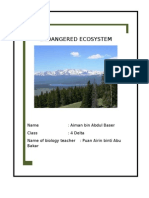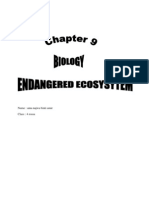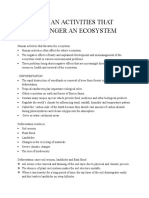Biodiversity
Biodiversity
Uploaded by
Teng Foo LimCopyright:
Available Formats
Biodiversity
Biodiversity
Uploaded by
Teng Foo LimCopyright
Available Formats
Share this document
Did you find this document useful?
Is this content inappropriate?
Copyright:
Available Formats
Biodiversity
Biodiversity
Uploaded by
Teng Foo LimCopyright:
Available Formats
Biodiversity
Biodiversity means the existence of interactions due to the differences of habitats and climates on earth. For example, the variety of species in an ecosystem in a forest are snakes, tigers, deer, elephants, monkeys, insects and trees such as timber. Diverse species of plants and animals interacting with one another are continuous processes which are important to create a balance biodiversity on earth. Nowadays, the human population has increased extremely rapid in this twenty-first century. The over exploitation of resources on earth brings negative impact to other living organisms as well as our mother earth. Now, the environment are in terrible situation and it has reached the alarming rate. The biodiversity crisis was highlighted many years ago as a direct result of human activities that are making tremendous negative impacts to the primate numbers in the wild. Destruction of habitats of the primates such as deforestation is almost certainly the primary cause of the decreasing of primate numbers. Deforestation is the act of extensive cutting down or burning the trees in a particular forest. Nowadays, vast areas of forests are cleared for extracting timber of fuel woods, agriculture and urban development. These actions could leads to soil erosion, flash flood and even landslides. Soil erosion may happen when the soil is exposed directly to the force of the rain water. Clearing of trees causes the loss of tree leaves to protect the soil from the raindrops and also causes the loss of tree roots to hold the soil in place. Rainfall could easily wash away the top layer of soil. On the other hand, during heavy rains, rain water flows quickly into river because there is no retention of water as well as water catchments areas. Due to silting in the river, the water flow is back. Thus, water flows inland and causes flash flood in low areas. When it rains for a long period of time during rainy seasons, the top layer of soil loosens and slides down eventually and causes landslides. Deforestation also leads to the lost of habitats for variety species of flora and fauna. The uncontrolled increase in the population of countries, more and more of their habitats is being cleared. Next, it will cause an increase rate of extinction of flora and fauna. Other living organisms become the victims of this phenomenon. Besides, large quantities of carbon dioxide is being produced daily. This is due to combustion such as combustion of fossil fuels in factories, motor vehicles and clearing of forests. Large scales of trees are destroyed by logging and burning, it will reduce rainfall, transpiration rate and the rate of using carbon dioxide during photosynthesis by plants. As a result, fewer trees are left to absorb carbon dioxide during photosynthesis process. Carbon dioxide become denser and has formed a layer in the atmosphere surrounding the earth. Heat and infrared rays reflected from the earth cannot pass through the layer of carbon dioxide into the outer space. Heat and infrared rays trapped and make the earth very warm. This phenomenon is commonly known as global warming. Global warming brings effects to the icebergs in the poles melt faster, causing the sea level to rise and the low lying areas along the coast getting flooded. In the same case, drought occurs in some dry region on earth forming famine and decline in the yield of crops due to dry and infertile soil. The same thing occurs where change in wind directions, climates and weather patterns as well.
Other than that, pollution nowadays becomes the top issue that every man may concern. It is common knowledge that pollution is endangering the earth and its inhabitant. There are three main types of pollutions which are air pollution, water pollution and thermal pollution. Air pollution occurs when pollutants such as poisonous gases released into the air endangering human life and living organisms. Examples of poisonous gases are carbon monoxide (CO), carbon dioxide (CO2), nitrogen oxide (NO) and sulphur dioxide (SO2). Carbon monoxide (CO) is the product of incomplete combustion of fossil fuels and motor vehicles exhaust. Carbon monoxide (CO) can bring effect to human health which prolonged exposure can lead to brain damage and even death. Carbon dioxide (CO2) causes emphysema and affects respiration. Next, nitrogen dioxide (NO2) can badly damage the lung tissues, causes bronchitis, irritates the eyes and lowers the bodys defence against flu as well. Whereas sulphur dioxide (SO2) leads to coughing, wheezing and form acid rain that may causes skin diseases. While lead and hydrocarbon may affect or retard mental development in children and may cause cancer. Talk about water pollution, the discharging agriculture wastes, industrial wastes, domestic wastes and sewage into rivers that pollute the water. Oil spills, sewage effluent and nonbiodegradable rubbish are examples of sources of water pollution. The effects towards living organisms where rubbish and oil spills on the surface of the water reduce light penetration and diffusion of oxygen into water causes aquatic organisms to die due to lack of light and oxygen. Grease and oil spills coated the gills of fishes affecting their respiration whereas decomposition of decayed materials by saprophytic bacteria reduces the oxygen content in the water. Furthermore, thermal pollution also occurs when there is an increase in the temperature of the water source or excessive heat in the environment. Many industries utilize water for cooling the machines. The hot water is discharged to rivers causing the water temperature to increase by 10 C. This process reduces the level of dissolved oxygen in water that affects the life of aerobic aquatic organisms and causes some aquatic organisms to die because they only survive at certain temperatures. Food chains in marine life are affected and next the entire ecosystem. Nowadays, man builds numerous of buildings where necessary are glass buildings. Reflection of heat from glass buildings also leads to an increase in temperature of the surroundings. Heat is reflected several times where heat energy is trapped at a fixed area. Another biodiversity crisis that could said to be serious is acid rain. Acid rain occurs when the acidity of the rain water is less that 5.0 since the natural rain water has a pH of about 5.4. Released of carbon dioxide, sulphur dioxide and oxides of nitrogen from combustion of fossil fuels and gases from factories contribute to acid rain. This is because carbon dioxide, sulphur dioxide and oxides of nitrogen form acidic solutions when dissolved in water vapour in the surrounding. These chemical reactions take place to form carbonic acids, sulphuric acids and nitric acids as well. These acidic solutions will fall back as acid rain. Acid rains can bring about serious consequences such as destroys plant tissues, damages plant roots and reduce the pH of the soil making it unsuitable for farming. It also corrodes metals, marble, rubber, plastics, stonework and other materials and increases the acidity of aquatic ecosystem leading aquatic organisms to die besides of causing low crops to produce low yields. This in turn affects the food supply.
Next, wide agricultural industry and urbanisation have used up the land. Fewer lands are left for the trees to re-grow for future use. In agriculture, excessive utilization of land for farming and stock rearing lead to infertile land and may expose soil to erosion by wind. Excess use of inorganic fertilisers such as urea, phosphates and nitrates deposited into ponds and rivers caused increase nutrients that promote rapid growth of algae which are called algae bloom. When the algae decays, they use up dissolved oxygen in the water and cause the other aquatic organisms to die. This pollution called eutrophication. Besides, excess pesticides from the farm can accumulate in the plants and eventually pass on to human beings through the food chains. Pesticides can also damage the liver, cause deformity in unborn babies and cancer in adults. Urbanisation however, produced unwanted wastes daily such as dumping of domestic wastes as well as sewage discharged from houses. Waste materials in landfills act as toxic substances are about to pollute nearby water sources that could also led to widespread destruction of marine life. However, every problem has its own solutions and so does biodiversity crisis. The ways to maintain biodiversity can be carry out through planning sustainable management in using natural resources. Natural resources such as energy are grouped into two common groups; renewable energy and non-renewable energy. People are encouraged to use renewable energy instead of nonrenewable energy. Examples of renewable energy are solar energy, wind energy, wave energy, hydroelectric energy, biomass energy and geothermal energy. Solar energy especially, is suitable to replace with electrical energy in reason of unlimited sunlight all year round almost every corner of the earth. Renewable energy is always available and cannot be depleted. Thus, renewable energy should be practise in our daily activities so will be continuously utilized by the next generations. The 3R, which are Reuse, Reduce and Recycle, should be practised by the communities to safe the environment. Reduce the usage of plastics in daily activities and can be replace with glass bottles and even aluminium Tiffin carriers for keeping food instead of using plastic containers. Wooden chairs can be use instead of plastic chairs. Plastics and papers for instance, can reuse in making of handicrafts or something creative and useful. Instead of reduce and reuse, used materials such as plastics can also be recycled in one of three ways; direct recycling, indirect recycling or energy recycling. Recycle of plastics helps in decreasing the usage of petroleum in the process of plastic making. Other than that, ecotourism should be greatly promoted to enable tourists to appreciate the importance and the beauty of the regional flora and fauna. Several of activities such as jungle trekking, mount climbing and camping trip enable tourists to being thankful to the Mother Nature. Besides, education is the best way to teach the public on the importance to maintain a balanced ecosystem. The objectives of Environmental Education are to increase awareness of the public towards the environment issues and to impart knowledge to individuals and society of the environment, problems of the environment as well as their duty and responsibility. Education can be divided into three stages; first, formal education which is carried out in any institutions. Second, mobile education such as give talks, slide shows and films shows about the environment. Third, the informal education that carried out through the mass media, campaigns, seminars, pamphlets, magazines and posters as well. Campaigns such as Environment Day and Recycle Day are carried out to educate and increase awareness among the community.
Meanwhile, the government has enacted many laws and regulation to protect our environment from destruction. Among the acts are Environmental Quality Act, 1974, 1985 it is the principal of legislation in regulating the prevention, abatement and control of pollution as well as the enhancement of the environment. Next, the National Forestry Act, 1984 where aims at protecting and preserving our forest and wildlife. The Pesticide Act, 1974, aims at controlling the use of pesticides. Apart from national laws, meeting and conferences were held at international level to discuss ways to protect our environment. For examples, Earth Summit was held in Rio de Janeiro in 1992, Langkawi Declaration in Langkawi, 1982 and Protocol Montreal, 1987. In this high technology era, modern technology can be used to reduce pollution and prevent further damage of the environment. Rubbish for example, is sorted into recyclable materials and non-recyclable materials. The non-recyclable materials can be burnt in incinerators where heat produced can be use in heating or to generate electricity. As well as the catalytic converters, functioning to reduce the amount of nitrogen oxides emitted and to convert harmful gases released during combustion of fossil fuels into less harmful products. Unleaded petrol can be used to replace with leaded petrol and sewage is treated before it is discharged into the water to reduce pollution. Solar energy cars are invented to reduce the combustion of fossil fuels. By the industrial side, filters are fixed on chimneys of factories to filtrate the amount of air pollutant as well. In conclusion, preservation and conservation should be carried out to protect the flora and fauna in the forests and mangrove swamps. Our forests are rich in wildlife. Therefore, conservation of our forests is aimed at maintaining the biodiversity. Preservation involves efforts and measures taken to protect the ecosystem so as to maintain the balance of nature whereas conservation involves steps and efforts taken to return an imbalanced ecosystem to its natural equilibrium. Preservation of water is very important to ensure that man can get continuous supply of clean water. Efforts taken are educating the public to care and love the rivers, lakes, seas and enforcing laws to prevent pollution. Mangrove swamps are rich in biodiversity. Mangrove swamps plays an important role in flood control, coastal erosion prevention, sediment control and as barrier against strong waves such as tsunami strikes. It also used for construction, building materials and as a source of fuels. Clearing of mangrove swamps for its timber robs the flora and fauna found in mangrove swamps of their habitats. Efforts must be made to preserve and conserve our mangrove swamps. Other than mangrove swamps, forests are also cleared in every year for human activities. Forests reserves are gazetted. Replanting of trees must be carried out. Reforestation ensures that forests are renewed. This effort is aimed to restore damaged forests for future needs. It should be a concerted effort between the government, private sectors and the communities to maintain and preserve our valuable diversity of life for future benefits. Biodiversity is at its utmost important as the sources of medicines, shelter and food. Many people including natives depend on the forests and their products for survival. In the same case, however, biodiversity play an important role for the environmental services. Nitrogen cycle, pollination and regulation of atmospheric temperature are provided due to the diversity in plants and animals, and the interaction among various organisms. For examples, mangrove swamps for coastal protection and the exchange of oxygen (O2) and carbon dioxide (CO2) during photosynthesis and respiration maintains the balance in the air. It also important as economic resources such as ecotourism contributes to the countrys economy.
All the resources supplied to us by our Mother Earth are not long-life supplier and now it is the time for human to pay back on what they have done before. Man should be thankful and appreciate our Mother Earth. Be a good man; care for the environment, think of our future.
You might also like
- A Level Environmental Management NotesDocument26 pagesA Level Environmental Management Notescharumbirakimtontapiwa751100% (3)
- Causes and Effects of DeforestationDocument3 pagesCauses and Effects of DeforestationYeswanth Raghavendra100% (1)
- 9.1 Human Activities That Endangered An Ecosystem Pollution: DeforestationDocument10 pages9.1 Human Activities That Endangered An Ecosystem Pollution: DeforestationsyahmisyahmiNo ratings yet
- Populations Can Be of The Same Size, But They May Have Different Densities. When We Consider The Number of IndividualsDocument3 pagesPopulations Can Be of The Same Size, But They May Have Different Densities. When We Consider The Number of IndividualsEmely CulveraNo ratings yet
- BiologyDocument22 pagesBiologyMuhamad FirdausNo ratings yet
- Biology Folio KSSM 2022 T5Document12 pagesBiology Folio KSSM 2022 T5LEE YEN NI MoeNo ratings yet
- Causes of Environmental DegradationDocument9 pagesCauses of Environmental DegradationAkanksha MhatreNo ratings yet
- Cours 1 PDFDocument4 pagesCours 1 PDFmayazeffouni04No ratings yet
- What Activities Disrupt The Cycles in Nature?: Presented By: Group 5Document12 pagesWhat Activities Disrupt The Cycles in Nature?: Presented By: Group 5Christina Jeraldine MendozaNo ratings yet
- GoegraphyDocument9 pagesGoegraphyNDATIMANA JOHNSONNo ratings yet
- Air PolutionDocument18 pagesAir PolutionNur Atikah AbdullahNo ratings yet
- UACE General Paper s101 General Paper Section A Discussion Topics Evironmental Degredation in UgandaDocument5 pagesUACE General Paper s101 General Paper Section A Discussion Topics Evironmental Degredation in Ugandajoviachloe497No ratings yet
- Causes and Effects of DeforestationDocument3 pagesCauses and Effects of DeforestationNhật NữNo ratings yet
- Environmental ProblemsDocument8 pagesEnvironmental Problemsliagiba_abbyNo ratings yet
- Folio Bio Form 4 Yay!!!!!!!!!!!!Document15 pagesFolio Bio Form 4 Yay!!!!!!!!!!!!Balqis RuslanNo ratings yet
- DeforestationDocument2 pagesDeforestationNeha SoniNo ratings yet
- Ecological Imbalance Part IDocument4 pagesEcological Imbalance Part Ibikramsubedi485No ratings yet
- Things We Cherish, Are HistoryDocument5 pagesThings We Cherish, Are HistoryAlma Rezza MantabuteNo ratings yet
- How Can I Help?: BiodiversityDocument15 pagesHow Can I Help?: Biodiversityrhythm_no1No ratings yet
- Group ActivityDocument5 pagesGroup ActivityJet GutierrezNo ratings yet
- Demo Session Science Grade 7Document8 pagesDemo Session Science Grade 7Malika MalikNo ratings yet
- Environmental IssuesDocument23 pagesEnvironmental IssuesAneen ZamanNo ratings yet
- Elaborate Consequence or Negative Effects of Environmental DegradationDocument8 pagesElaborate Consequence or Negative Effects of Environmental DegradationAbdela Aman MtechNo ratings yet
- Folio Biology Form 4Document31 pagesFolio Biology Form 4Amin Rosnan0% (1)
- Deforestation: Causes, Consequences and SolutionsDocument8 pagesDeforestation: Causes, Consequences and SolutionsÄlejÄndro Quevedo RomeroNo ratings yet
- 2 BiologyDocument30 pages2 BiologyAiman Abdul BaserNo ratings yet
- Social Studies HandoutDocument103 pagesSocial Studies Handoutestheronkabetse2No ratings yet
- Environmental Concepts & ConcernsDocument10 pagesEnvironmental Concepts & Concernsestheronkabetse2No ratings yet
- Waste Management 2Document6 pagesWaste Management 2tvkeliye9No ratings yet
- 5 Positive and 5 Negative Environmental Impacts Done by HumanityDocument4 pages5 Positive and 5 Negative Environmental Impacts Done by HumanityAriana GonzálezNo ratings yet
- Social Impact of Technology SO245 Assignment 4Document4 pagesSocial Impact of Technology SO245 Assignment 4Osvaldo CangasNo ratings yet
- Part 1Document3 pagesPart 1Manikanta RamakrishnaNo ratings yet
- Name: Aina Najwa Binti Amir Class: 4 RossaDocument15 pagesName: Aina Najwa Binti Amir Class: 4 RossaAina NajwaNo ratings yet
- DeforestationDocument1 pageDeforestationOanh NguyenNo ratings yet
- How Do Humans Affect The EnvironmentDocument3 pagesHow Do Humans Affect The EnvironmentmynameNo ratings yet
- Geography Environmental ManagementDocument24 pagesGeography Environmental ManagementMirriamNo ratings yet
- Sains SPM Chapter 3 Form 5Document11 pagesSains SPM Chapter 3 Form 5Noorain MohammadNo ratings yet
- Sains SPM Chapter 3 Form 5Document10 pagesSains SPM Chapter 3 Form 5秀珍100% (1)
- DESERTIFICATIONDocument8 pagesDESERTIFICATIONWhiskey /No ratings yet
- JJ SO245 Assignment4Document4 pagesJJ SO245 Assignment4Jolanie JohnsonNo ratings yet
- Water and Air PollutionDocument4 pagesWater and Air Pollutionm.maryam2526No ratings yet
- Water Pollution: Fishing TourismDocument12 pagesWater Pollution: Fishing TourismNairdax Navie Ziur OzilacNo ratings yet
- ENVIRONMENTAL SCIENCE Prelim ReviewerDocument14 pagesENVIRONMENTAL SCIENCE Prelim ReviewerMichael MendozaNo ratings yet
- What Is Deforestation?: Endangered EcosystemDocument7 pagesWhat Is Deforestation?: Endangered Ecosystemkhaty95No ratings yet
- Causes and History of Acid RainDocument12 pagesCauses and History of Acid RainJay PeeNo ratings yet
- Folio BiologiDocument5 pagesFolio BiologiPrincipessa FarhanaNo ratings yet
- 4 Degradation L.Document24 pages4 Degradation L.monasteriomatthew7No ratings yet
- Assignment#2 What Would Happen If All The Trees in The World Die?Document5 pagesAssignment#2 What Would Happen If All The Trees in The World Die?niyasph90No ratings yet
- 36.Management and Conservation of EnvDocument7 pages36.Management and Conservation of Envlukesande023No ratings yet
- Group 2Document1 pageGroup 2Lungdy PrakNo ratings yet
- Gas and Environment Pollution: Global WarmingDocument6 pagesGas and Environment Pollution: Global Warmingadeelafzal_00162No ratings yet
- Evs AssingmentDocument8 pagesEvs Assingment22510051 Asmi VashishthaNo ratings yet
- Biology FolioDocument12 pagesBiology Foliomuhd khobirNo ratings yet
- Environment Persuasive 2Document1 pageEnvironment Persuasive 2api-254670334No ratings yet
- DeforestationDocument21 pagesDeforestationAbhishek AryaNo ratings yet
- The Effects of Unplanned DevelopmentDocument11 pagesThe Effects of Unplanned Developmentridwan78% (9)
- 9.1 Human Activities That Endanger An EcosystemDocument7 pages9.1 Human Activities That Endanger An EcosystemMuhamad FirdausNo ratings yet
- Bio Folio Form 4Document10 pagesBio Folio Form 4Ahmad FaizNo ratings yet
- Climate Change: Name & Section: Abdulla Alfawads C. Rajab BSAM2CDocument3 pagesClimate Change: Name & Section: Abdulla Alfawads C. Rajab BSAM2CLongyapon Sheena StephanieNo ratings yet
- Geothermal Energy Campaign: Presented by Christian Hernandez Grade 9 JasperDocument16 pagesGeothermal Energy Campaign: Presented by Christian Hernandez Grade 9 JasperJoyce RamirezNo ratings yet
- Project Report On Smart Vertical Axis Highway Wind TurbineDocument7 pagesProject Report On Smart Vertical Axis Highway Wind TurbineSandeep JaiswalNo ratings yet
- Total in 2 Inverters 102 ModulesDocument1 pageTotal in 2 Inverters 102 Modulesdheisatlubna1No ratings yet
- Photovoltaic System Efficiency Improvement MethodsDocument24 pagesPhotovoltaic System Efficiency Improvement MethodsradiNo ratings yet
- PV Light-ReflectionDocument12 pagesPV Light-ReflectionNURUL IDAYUNo ratings yet
- Reverse Power Flow: 1. Negative Current InfluenceDocument2 pagesReverse Power Flow: 1. Negative Current InfluenceManorath PrasadNo ratings yet
- EE4504 - Week 9Document12 pagesEE4504 - Week 9Daniel ChaiNo ratings yet
- Namibia Electricity Supply Demand Options March 2008 FINALDocument235 pagesNamibia Electricity Supply Demand Options March 2008 FINALVeikko212No ratings yet
- Renewable Energy Annual 2007: Release Date: April 2009 Doe/Eia Next Release Date: April 2010Document137 pagesRenewable Energy Annual 2007: Release Date: April 2009 Doe/Eia Next Release Date: April 2010Amr RamzyNo ratings yet
- Solar Policy: When Went DigitalDocument28 pagesSolar Policy: When Went DigitaldubryNo ratings yet
- Soalr Commissioned PRJ 30.01.14Document9 pagesSoalr Commissioned PRJ 30.01.14ankittrivediNo ratings yet
- FBM400MFG BBDocument1 pageFBM400MFG BBsaid.med.islam.1991No ratings yet
- Green Jobs and Women Workers. Employment, Equity, Equality. (Sustainlabour, 2009)Document20 pagesGreen Jobs and Women Workers. Employment, Equity, Equality. (Sustainlabour, 2009)Sustainlabour- International Labour Foundation for Sustainable DevelopmentNo ratings yet
- EUMEPS Brochure EnvironmentDocument32 pagesEUMEPS Brochure EnvironmentudungeNo ratings yet
- Ielts 4Document127 pagesIelts 4zholdasaibikeNo ratings yet
- Task 1: 1. The Graph Below Shows Electricity Production (In Terawatt Hours) in France Between 1980 and 2012Document9 pagesTask 1: 1. The Graph Below Shows Electricity Production (In Terawatt Hours) in France Between 1980 and 2012abcd1234No ratings yet
- Solar Updraft TowerDocument8 pagesSolar Updraft Towerbobo_sbNo ratings yet
- Solar Energy Potential in Nepal and Global Context: Tuta/Ioe/PcuDocument12 pagesSolar Energy Potential in Nepal and Global Context: Tuta/Ioe/PcuJuju R ShakyaNo ratings yet
- Trustedsolarprices - Co.uk - Panel ComparisonDocument2 pagesTrustedsolarprices - Co.uk - Panel ComparisonperlenceNo ratings yet
- CH 2023's ProfileDocument10 pagesCH 2023's ProfileIskandar Ismail.07No ratings yet
- SteagDocument7 pagesSteaglea grace raupanNo ratings yet
- Green Engineering: Create, Enhance and SustainDocument23 pagesGreen Engineering: Create, Enhance and Sustainnandan akNo ratings yet
- IJET 10239ourpublishedresearchpaper3Document6 pagesIJET 10239ourpublishedresearchpaper3Username4653No ratings yet
- Analysis of Large Scale PV Penetration Impact On IEEE 39-Bus Power SystemDocument6 pagesAnalysis of Large Scale PV Penetration Impact On IEEE 39-Bus Power SystemABDULLAH MUNIR PKE183017No ratings yet
- Accepted ChaosDocument2 pagesAccepted Chaosanjalijha1895No ratings yet
- Heterointerface Engineering For Enhancing Electrochemical Performance of Solid Oxide CellsDocument38 pagesHeterointerface Engineering For Enhancing Electrochemical Performance of Solid Oxide Cellsantonello tebanoNo ratings yet
- Cutler's Energy and Environment Press PacketDocument18 pagesCutler's Energy and Environment Press PacketthisdogNo ratings yet
- Lecture1-7Introduction To EnvironmentDocument111 pagesLecture1-7Introduction To EnvironmentRitesh KumarNo ratings yet
- Electricity Consumption ThesisDocument5 pagesElectricity Consumption Thesisfczeohief100% (2)
- Power Curve UpgradeDocument2 pagesPower Curve Upgrademuruga dossNo ratings yet

























































































